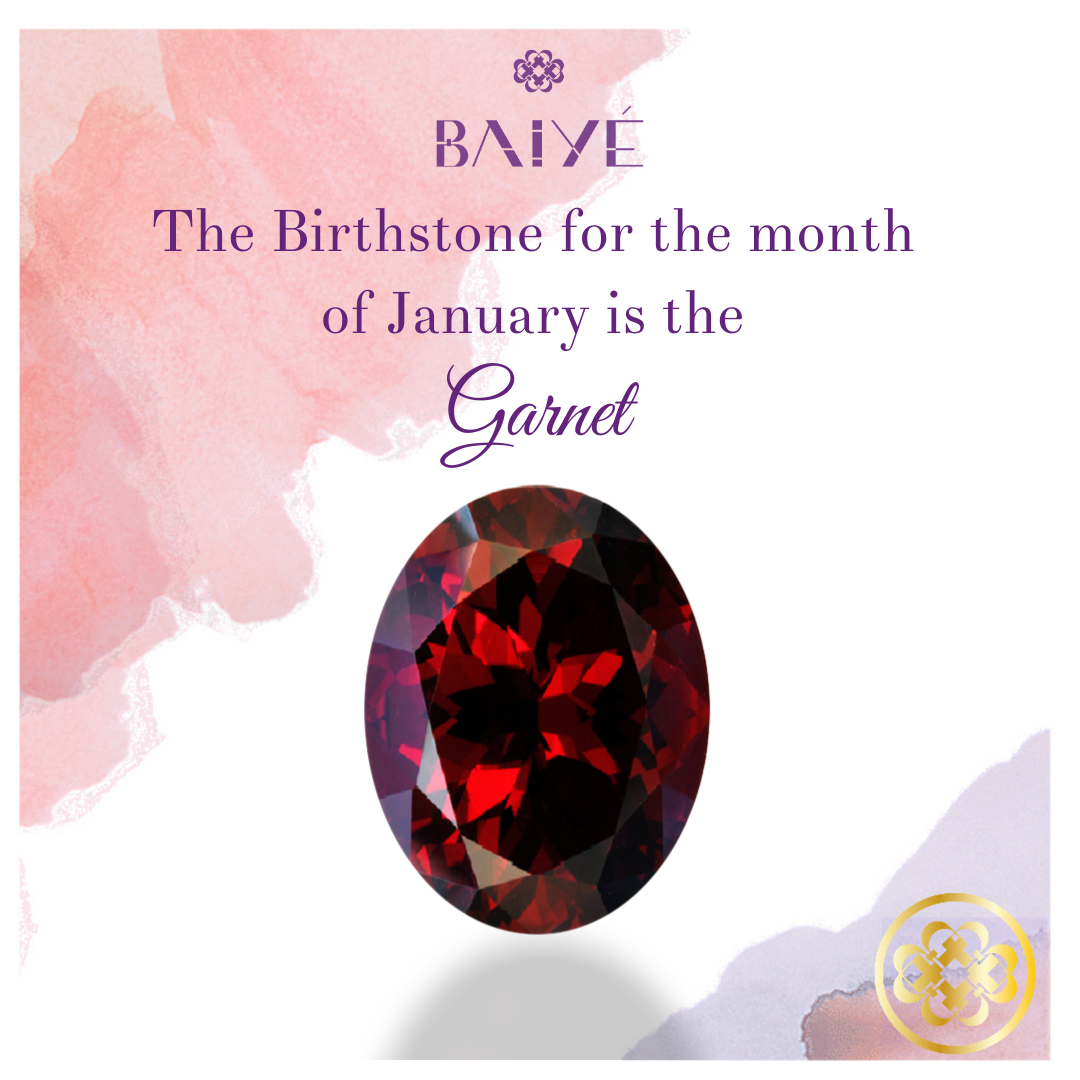
Garnet: The Birthstone for January

The birthstone for January is the gorgeous garnet.
Garnet is the name used for a collection of minerals that come in a rainbow of colours, from the Pyrope garnet which is a deep red hue to my personal favourites the vibrant green Tsavorites.Some rare garnets are even blue or colourless, while you may find a very very rare garnet that changes colours in different lights.
The origin of the word “garnet” has two stories, the first says it comes from the 14th Century Middle English word “gernet” meaning dark red, while the other says it comes from the Latin word “Garanatus,” meaning “seedlike,” in reference to a pomegranate. This reference makes sense, as small garnets look like bright red seeds, similar to the beautifully red seeds of the pomegranate.
Evident from the history of its name, the most common colour is the beautiful range of reds, from rust coloured red to deep violet-red, this is probably why most people associate it with burgundy.
The garnet is a very durable gemstone, with a hardness of 6.5-7.5 on the Mohs scale. The garnet is so durable, remnants of garnet jewellery can be found as far back as the Bronze Age.
Other references go back to 3100 BC when the Egyptians used garnet as inlays in their jewellery and carvings. The Egyptians even said it was the symbol of life, others believe it signifies everlasting friendship, constancy & Trust, with this symbolism you’re expected to give a garnet to someone whose friendship you deeply value.
The garnet was very popular with the Romans in the 3rd and 4th Century, often used as signet rings in ancient Rome, favoured by the nobility in the Middle Ages.
The Victorians made garnets very popular during that time period. Some of the loveliest garnet jewellery from that era mimics its pomegranate namesake, with clusters of tiny red gems forming a larger statement piece.
MYTHS AND LEGENDS
The myths and legends about the garnet are numerous.
One legend has it that the garnet brings peace, prosperity and good health to the home. Some even called it the “Gem of Faith,” and believed that to those who wear it and do good, more good will come while those who wear it and commit bad acts while wearing it attract bad fortune to themselves.
This gemstone was also used as a talisman for protection both by warriors going into battle and by those who wanted to ward off pestilence and plague. Some ancient healers and wise men would place garnets in wounds and praised its healing powers.
Some legends say Garnets light up the night and protect their owners from nightmares. Garnets have long been carried by travellers to protect against accidents far from home.
It is found in various parts of the world, including Wyoming in the United States of America, Czech Republic, Greece, Russia, Tanzania, Madagascar, Sri Lanka and India.
Specific garnets are typical to their places of origin, an example of this is:
Pyrope found in China, Madagascar, Myanmar (Burma), South Africa, Sri Lanka, Tanzania and the USA.
Rhodolite found in Brazil, India, Sri Lanka, Thailand and the USA.
Almandine found in Brazil, India, Madagascar, Sri Lanka and the USA.
PURCHASING GARNET JEWELLERY
Today, the garnet can be found in a range of jewellery pieces and styles, from beautiful rings to stunning tiaras. Since the garnet can come in a range of colours, rare garnets in green or blue make breathtaking pieces, especially in pendants or drop earrings.
If you’re looking to purchase a garnet for yourself or a loved one, it is a great way to celebrate friendship, toast a 2nd wedding anniversary or recognise the wearer’s January birthday.
Remember, this gem is available in a rainbow of colours, from the deep red Bohemian Garnet to the vibrant greens of the Russian Demantoid and African Tsavorite. We also see it appearing in the oranges and browns of Spessartite and Hessonite from Namibia and Sri Lanka and the subtle pinks and purples of Rhododendron. The price of the piece will likely increase for more rare colours like green or blue. From the fiery orange of Mandarin Garnet to the rich green of Tsavorite Garnet and to the most widely recognised colour of Pyrope Garnet, the garnet is always considered a great gift.
Garnets can also be judged along some of the same parameters as diamonds, with clarity and cut affecting the beauty and value of the stone.
It should be noted that some garnets have inclusions that are part of the beauty of the overall stone (like “horsetails” in Demantoid garnets, or Hessonite garnets which sometimes have a “turbulent” look). So you may discover that you like the unique look these inclusions bring to the piece.
Try to find a cut that spreads light evenly over the surface of the gemstone. This will help to bring out the overall beauty and colour of the garnet.
No matter which stone or piece you choose, remember that the garnet is known for its durability and richness of colour, so your investment will not only have great emotional value but could be a piece that stands the test of time.
Prices range from $500 a carat for good colours with some inclusions, to $1,000 to $2,000 for clean larger stones with top colour. Demantoid garnet is the rarest and most valuable of the garnets and is one of the rarest of all coloured gemstones. It is remarkable for its brilliance and fire.
No matter why or how you wear garnet, this beautiful gemstone is perfect for those who share January birthdays and get to start each New Year with a sense of goodwill, happiness, and purpose.
Please comment, like and share.
Speak soon,
Funto.

3 comments
Nice write up. Very informative
Wow! I learnt a lot reading this.
Lovely write up, very educative, thanks